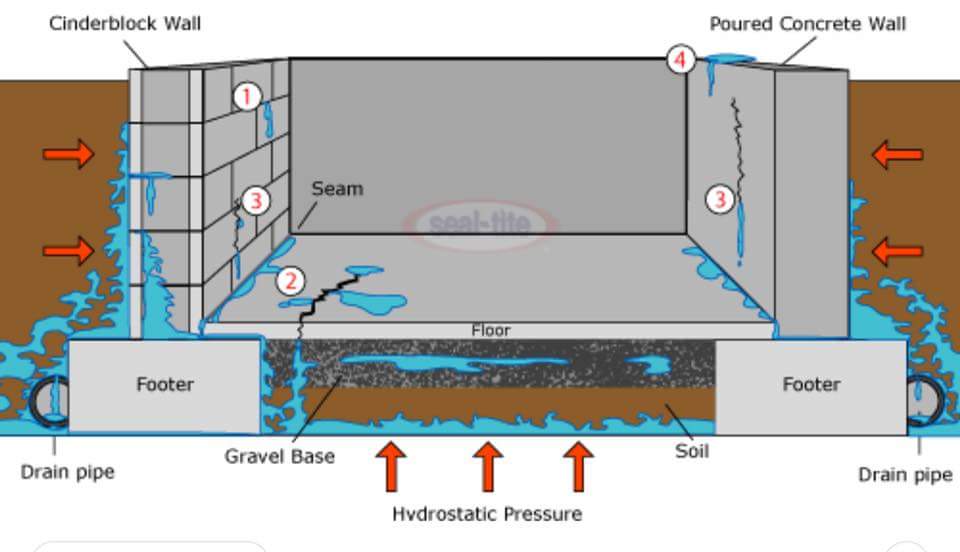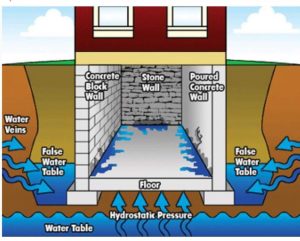Hydrostatic Pressure – What You Need to Know


Water always finds a way. The Grand Canyon was formed by the never ending flow of water over a long period of time. The result is a beautiful, majestic site that millions of people visit every year. However, water flowing into your basement is a different story. Now add some pressure actually pushing the water into your basement and you have a recipe for disaster. Water is the enemy of your new home. Let’s talk about what hydrostatic pressure is and how you can beat it to protect your home!
What is Hydrostatic Pressure?
Hydrostatic pressure refers to a water pressure and is a major cause of basement water problems. At its simplest, hydrostatic pressure is the pressure created by standing or resting (“static”) water (“hydro”). Remember the story of the little Dutch boy that saves his town by placing his finger in the leaky dyke? That is a great example of hydrostatic pressure. The resting water found a hole and then, because of the weight behind it, found its way into the dry side of the dyke attempting to flood his town. That same relentless pressure can impact your concrete walls and floors too.
Water weighs about 62.5 lbs. per cubic foot. If the soil around your basement is saturated with water, there could be tens of thousands of pounds of hydrostatic pressure against your foundation from the water trapped in the soil. That’s a lot of pressure and it’s likely that some water will find its way through even the smallest crack or gap in your basement.
What Causes Hydrostatic Pressure?
 Hydrostatic pressure, by definition, cannot occur in slabs above grade. It does not even occur in every slab below the soil line. For a concrete slab to be impacted by hydrostatic pressure, it must be below the water table or intrude into a natural water pathway.
Hydrostatic pressure, by definition, cannot occur in slabs above grade. It does not even occur in every slab below the soil line. For a concrete slab to be impacted by hydrostatic pressure, it must be below the water table or intrude into a natural water pathway.
Water, underground as well as above, moves downhill under the pull of gravity Sites cut into a hillside stand a greater risk of having the “hillside side” be affected by hydrostatic pressure if adequate steps to redirect the water (and the subsequent pressure that might build up as it accumulates) are not taken. Poor drainage may cause water to collect against a concrete foundation but generally will not build up the volume to cause problems attributable to hydrostatic pressure. Steps taken to direct water flow away from basements/foundations and eliminate pooling will reduce the chances of water build up around a home.
How Does Water Get Into My Basement?
If you allow water to pool near your foundation or don’t direct water away from the walls of your foundation, it is just a matter of time before water finds its way in. First, most foundations are constructed of concrete. While concrete is a relatively solid material when dry, it isn’t technically solid in the same way that stainless steel or marble is. It isn’t impervious to moisture.
A concretes strength is also an indicator of its density or ability to resist water. For example, a concrete block is poured with 2,500 psi (pounds per square inch) concrete. It is porous and will let moisture into your basement easily. Poured concrete walls are typically poured at 3,500 psi. They are stronger than concrete blocks but still water vapor can find its way through. Concrete is considered waterproof at 4,400 psi. An engineered foundation known as Superior Walls is poured at 5,000 psi. Technically, their walls are waterproof.
 A new foundation is sealed like a fish aquarium. However, with a foundation, there are seams at locations such as doorways, windows, and where the slab and walls meet. Concrete will crack over time. It just does. Water is amazing. It will always find any tiny crack or fissure n the concrete. It is on a mission to find the easiest path to get to the inside of your basement or foundation. If water is allowed to pool or drain toward one of these seams, in some cases during a storm, it can seem like a geyser is erupting at these points. The best cure is prevention.
A new foundation is sealed like a fish aquarium. However, with a foundation, there are seams at locations such as doorways, windows, and where the slab and walls meet. Concrete will crack over time. It just does. Water is amazing. It will always find any tiny crack or fissure n the concrete. It is on a mission to find the easiest path to get to the inside of your basement or foundation. If water is allowed to pool or drain toward one of these seams, in some cases during a storm, it can seem like a geyser is erupting at these points. The best cure is prevention.
Can I Prevent Hydrostatic Pressure from Impacting my Basement?
Avoiding the build-up of hydrostatic pressure can be planned into the site design and foundation design of your new home. Grading also plays a direct role in protecting your home.
- Gutters and downspouts that are drained away from the foundation.
- Grading that guides water away from the foundation.
- Swales in grading that directs any moving water away from and around the foundation at a distance.
- Drainage layer of gravel eliminates trapping water laden soil against foundation walls.
- Drains below slabs that direct water to natural exit (let gravity work for you).
Keep water away from the basement and maintain caulking around doors and windows. Inspect the walls and floors. If cracks appear, repair or seal them immediately. Water has a way of finding a small entryway and then making it bigger over time.
Building Your New Modular Home on a Well Designed Foundation
Any good home begins with a good foundation. Moisture is the enemy of a home. Once water enters a basement, it begins to evaporate. The only place for the moisture to go is up. Up into the rest of the home. Modular homes today are very energy efficient with tight building envelopes. Water that gets into your basement and tries to evaporate will only cause more problems for the rest of your home. Without proper ventilation, the moisture is trapped. Don’t let this happen. Plan to eliminate hydrostatic pressure from your new home.
The post Hydrostatic Pressure – What You Need to Know appeared first on Impresa Modular.




